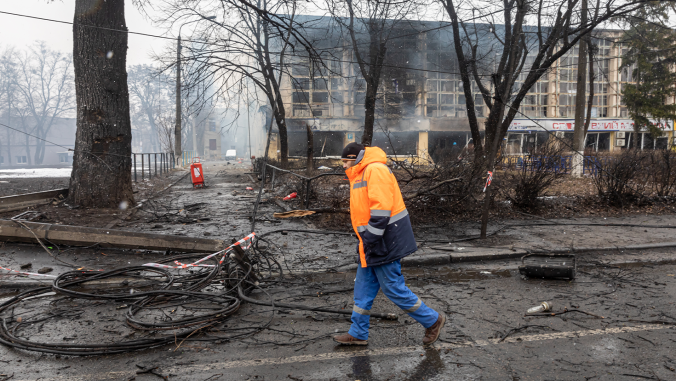The data on green data centers is still pretty cloudy
Efficiency gains and clean power investments are adding up for companies such as Google, Microsoft and Facebook, but the pace of digital expansion is making it tough to keep up.

The cloud is coming back to Earth with a bump. That ethereal place where we store our data, stream our movies and email the world has a physical presence — in hundreds of giant data centers that are taking a growing toll on the planet.
Data centers are the factories of the digital age. These mostly windowless, featureless boxes are scattered across the globe — from Las Vegas to Bangalore, Des Moines to Reykjavik. They run the planet’s digital services. Their construction alone costs around $20 billion a year worldwide.
The biggest, covering a million square feet or more, consume as much power as a city of a million people. In total, they eat up more than 2 percent of the world’s electricity and emit roughly as much CO2 as the airline industry. And with global data traffic more than doubling every four years, they are growing fast.
Yet if a data center is near you, the chances are you don’t know about it. And you still have no way of knowing which center delivers your Netflix download, nor whether it runs on renewable energy using processors cooled by Arctic air, or runs on coal power and sits in desert heat, cooled by gigantically inefficient banks of refrigerators.
We are often told that the world’s economy is dematerializing — that physical analog stuff is being replaced by digital data, and that this data has a minimal ecological footprint. But not so fast. If the global IT industry were a country, only China and the United States would contribute more to climate change, according to a Greenpeace report investigating "the race to build a green internet," published last year.
Storing, moving, processing and analyzing data all require energy. Lots of it. The processors in the biggest data centers hum with as much energy as can be delivered by a large power station, 1,000 megawatts or more. And it can take as much energy again to keep the servers and surrounding buildings from overheating.You still have no way of knowing whether the data center delivering your favorite movie or mobile app runs on clean energy.
Almost every keystroke adds to this. Google estimates that a typical search using its services requires as much energy as illuminating a 60-watt light bulb for 17 seconds and typically is responsible for emitting 0.2 grams of CO2. Which doesn’t sound a lot until you begin to think about how many searches you might make in a year.
And these days, Google is data-lite. Streaming video through the internet is what really racks up the data count. IT company Cisco, which tracks these things, reckons video will make up 82 percent of internet traffic by 2021, up from 73 percent in 2016. Around a third of internet traffic in North America is already dedicated to streaming Netflix services alone.
Two things matter if we are to tame these runaway beasts: One is making them use renewable or other low-carbon energy sources; the other is ramping up their energy efficiency. On both fronts, there is some good news to report. Even Greenpeace said so. "We are seeing a significant increase in the prioritization of renewables among some of the largest internet companies," last year’s report concluded.
More IT companies are boasting of their commitment to achieving 100 percent reliance on renewable energy. To fulfill such pledges, some of the biggest are building their own energy campuses. In February, cloud giant Switch, which runs three of the world’s top 10 data centers, announced plans for a solar-powered hub in central Nevada that will be the largest anywhere outside China.
More often, the data titans sign contracts to receive dedicated supply from existing wind and solar farms. In the U.S., those still can be hard to come by. The availability of renewable energy is one reason Google and Microsoft recently have built hubs in Finland, and Facebook in Denmark and Sweden. Google last year also signed a deal to buy all the energy from the Netherlands’ largest solar energy park, to power one of its four European data centers.
Of the mainstream data crunchers for consumers, Greenpeace singled out Netflix for criticism. It does not have its own data centers. Instead, it uses contractors such as Amazon Web Services, the world’s largest cloud-computing company, which Greenpeace charged with being "almost completely non-transparent about the energy footprint of its massive operations."
Amazon Web Services contested this. A spokesperson told Yale Environment 360 that the company had a "long-term commitment to 100 percent renewable energy" and had launched a series of wind and solar farm projects able to deliver around 40 percent of its energy. Netflix did not respond to requests for comment.
Amazon Web Services has some of its largest operations in Northern Virginia, an area just over the Potomac River from Washington D.C. that has the largest concentration of data centers in the world. Virginia gets less than 3 percent of its electricity from renewable sources, plus 33 percent from nuclear, according to Greenpeace.
Some industry insiders detect an element of smoke and mirrors in the green claims of the internet giants. "When most data center companies talk about renewable energy, they are referring to renewable energy certificates," Phillip Sandino, vice-president of data centers at RagingWire, which has centers in Virginia, California and Texas, claimed in an online trade journal recently. In the U.S. and some other countries, renewable energy certificates are issued to companies generating renewable energy for a grid, according to the amount generated. The certificates can be traded and used by purchasers to claim their electricity is from a renewable source, regardless of exactly where their electricity comes from. "In fact," Sandino said, "the energy [the data centers] buy from the power utility is not renewable."
Others, including Microsoft, help sustain their claims to carbon neutrality through carbon offsetting projects, such as investing in forests to soak up the CO2 from their continued emissions.

Meanwhile, there is growing concern about the carbon footprint of centers being built for Asian internet giants such as Tencent, Baidu and Alibaba in China; Naver in South Korea; and Tulip Telecom in India. Asia is where the fastest global growth in data traffic is taking place. These corporations have been tight-lipped about their energy performance, claimed Greenpeace. But with most of the region’s energy coming from coal-fired power stations, their carbon footprint cannot be anything but large.
Vattenfall estimates the carbon emissions in Bangalore, home of Tulip’s giant Indian data center, at 900 grams per kilowatt-hour. Even more troubling, the world’s largest center is the Range International Information Hub, a cloud-data store at Langfang near the megacity of Tianjin in northeast China, where it takes more than 1,000 grams of CO2 for every kilowatt-hour.
Almost as important as switching data centers to low-carbon energy sources is improving their energy efficiency. Much of this comes down to the energy needed to keep the processors cool. Insanely, most of the world’s largest centers are in hot or temperate climates, where vast amounts of energy are used to keep them from overheating. Of the world’s 10 largest, two are in the desert heat of Nevada, and others are in Georgia, Virginia and Bangalore.
Most would dramatically reduce their energy requirements if they relocated to a cool climate such as Scandinavia or Iceland. One fast-emerging data hub is Iceland, where Verne Global, a London company, set up its main operation.
The campus, on the site of an old U.S. Navy base, exchanges data using fiber-optic cables first installed for military use. It is powered by the country’s extensive hydroelectric and geothermal energy sources, initially developed for aluminum smelting. In Iceland, temperatures hover around zero Celsius for much of the year. "It is all natural cooling here," said Verne’s chief technology officer Tate Cantrell, when I visited the complex in 2016. "Our chiller is an open window."
Verne’s clients include European companies with large data processing needs, such as German car giants BMW and Volkswagen, as well as companies running energy-intensive computation for bitcoin "mining."
Other Nordic data companies also take advantage of the region’s climate. Norway’s biggest bank, DNB, runs its main data center in an underground bunker near Stavanger that is cooled by freezing water from a neighboring fjord. Meanwhile, the world’s largest data center is planned for Ballangen, a small Norwegian fjord town inside the Arctic Circle, adjacent to the Lofoten Islands.
The industry’s standard measure of energy efficiency is the Power Use Effectiveness (PUE), an index that divides the total amount of energy used in the center by the amount needed to run the processors themselves.
An industry analysis a decade ago in the U.S. found an average PUE of 2.5, suggesting that total energy use, including cooling, was 2.5 times the energy expended on running the processors. Best practice PUE was reckoned back then at 1.6.
Since then, things dramatically have improved. A study published last year on European data centers reckoned the average is around 1.8. But Nordic companies with minimal cooling requirements claim to do a lot better. And Google is far from alone in claiming an average of 1.12. Still, there is a giant gap between industry average and best practice.
A report published in 2016 by the Lawrence Berkeley National Laboratory for the U.S. Department of Energy estimated that improved efficiency is almost canceling outgrowing capacity in the data center business. It found that in 2014, U.S. centers used 70 billion kilowatt-hours (kWh), but it expected only a modest rise to 73 billion kWh by 2020. It noted that if energy efficiency levels had remained as they were 2010, current energy demand would by now be approaching 160 billion kWh.
Even so, the improvements are relative. By implementing best practice, the report said, electricity use could have been more than a third less (PDF) than current rates.
The next step is not just to dissipate the heat coming off processors, but to make productive use of it. Again, a cold climate is handy here. It makes heat a valuable commodity. DigiPlex’s Stockholm complex will divert its hot air to heat water running through the city’s district heating system. It eventually will heat some 10,000 apartments.
Fredrik Jansson, chief strategy officer at DigiPlex, is proud of this project: "When my son is on his iPad at home in Stockholm, I can tell him that his digital activities end up helping heat the radiator in his room."The processors in the biggest data centers hum with as much energy as can be delivered by a large power station, 1,000 megawatts or more.
As the energy costs of cooling data centers come down, however, the calls will increase to save more energy. The drive for more efficient chips continues. But DigiPlex is working with academics at the University of Leeds in England who are investigating making cooling more efficient by placing chips in direct contact with water or some other liquid. This eventually could cut cooling costs by 80 percent or more, the university’s Jon Summers estimates.
Greenpeace said the very size of the internet business, and its exposure to criticism for its contribution to climate change, has the potential to turn it from being part of the problem to part of the solution. Data centers have the resources to change rapidly. And pressure is growing for them to do so.
The hope is that they will bring many other giant corporations with them. "The leadership by major internet companies has been an important catalyst among a much broader range of corporations to adopt 100 percent renewable goals," said Gary Cook, lead author of the Greenpeace report. "Their actions send an important market signal."
But the biggest signal, said Fox, will come from us, the digital consumers. Increasingly, he said, "they understand that every cloud lives inside a data center. And each has a different footprint." We soon, he believes, will all demand to know the carbon footprint of our video streams and internet searches. The more far-sighted of the big data companies are gearing up for that day. "I fully expect we may see green labelling for digital sources as routine within five years."
This story first appeared on:





